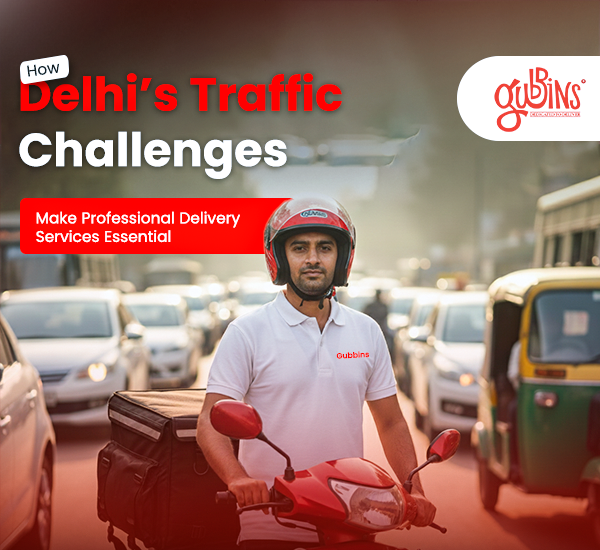
.png)
How Same-Day Delivery Works & Why It’s in High Demand | Fast Shipping Explained
Gubbins | 2025-04-30In today’s on-demand economy, same-day delivery is rapidly becoming the gold standard for customer satisfaction. What was once considered a premium service is now a critical differentiator for retailers and service providers looking to stay competitive in a market where convenience is king. From groceries and gadgets to medicine and fashion, consumers expect their orders to arrive almost as quickly as they were placed.
But meeting that expectation requires more than just speed—it demands a well-oiled system of technology, logistics, and strategy. In this blog post, we’ll take a closer look at how same-day delivery works, why it’s in such high demand, and what businesses need to know to stay ahead in this fast-moving space.
What Is Same-Day Delivery?
Same-day delivery is a logistics service that ensures orders are picked, packed, shipped, and delivered to the customer on the very day the purchase is made—often within a few hours.
Key takeaway: Same-day delivery closes the gap between online and in-store shopping, offering near-instant gratification.
How Same-Day Delivery Works:
Achieving same-day delivery requires a highly coordinated logistics ecosystem that integrates technology, inventory management, and transportation. Here's a breakdown of the process:
1. Distributed Warehousing or Micro-Fulfillment Centers
- Retailers use local fulfillment centers strategically located near urban populations.
- These hubs stock high-demand inventory based on predictive analytics.
2. Real-Time Inventory Management
- Robust inventory tracking systems ensure accurate stock levels.
- Integration with e-commerce platforms allows for instant updates and order processing.
3. Smart Order Routing
- Algorithms determine the fastest fulfillment location based on:
- Product availability
- Proximity to the delivery address
- Courier availability
4. Last-Mile Delivery Networks
- Partnered with third-party logistics (3PL) providers or gig economy drivers (e.g., Gubbins, Uber, Postmates).
- GPS tracking and route optimization software reduce delays and costs.
5. Customer Communication
- Real-time updates, tracking links, and delivery windows enhance customer satisfaction and transparency.
Why Same-Day Delivery Is in High Demand
1. Changing Consumer Expectations
- The Amazon Effect has reshaped what customers expect from shipping—fast, free, and flexible.
- 56% of online shoppers between ages 18-34 expect same-day delivery options at checkout.
2. Competitive Differentiator
- Offering same-day delivery boosts customer loyalty and increases conversion rates.
- It provides a significant edge in saturated markets.
3. Growth of Urban E-Commerce
- Dense city populations allow for efficient delivery routes and shorter transit times.
- Local retailers and D2C brands are leveraging this to stay competitive.
4. Healthcare and Perishables
- Industries like pharmaceuticals, groceries, and florals require rapid delivery due to the nature of the goods.
- Same-day delivery meets these time-sensitive needs.
Technologies Powering Same-Day Delivery
Modern logistics is impossible without the right technology stack. Here are key innovations driving same-day fulfillment:
• Artificial Intelligence (AI)
- Predictive analytics forecast demand spikes and stock allocation.
• Internet of Things (IoT)
- Smart sensors and RFID tags provide real-time tracking of shipments.
• Autonomous Vehicles & Drones (Emerging)
- Companies like Amazon and Zipline are piloting automated delivery vehicles and drones.
• Route Optimization Software
- Machine learning algorithms reduce delivery time by analyzing traffic patterns, weather, and drop-off windows.
Pros and Cons of Same-Day Delivery
✅ Pros
- Enhanced Customer Experience
- Increased Sales and Conversions
- Competitive Advantage
- Reduced Cart Abandonment
❌ Cons
- Higher Operational Costs
- Logistical Complexity
- Limited Geographic Reach
- Dependency on 3PL Providers
How Businesses Can Implement Same-Day Delivery
Implementing same-day delivery involves more than just fast shipping. Here's a roadmap for businesses considering this model:
1. Evaluate Demand and Product Type
- Is there a real need for speed for your product category?
2. Optimize Your Supply Chain
- Invest in inventory visibility, automation, and demand planning tools.
3. Partner with the Right Fulfillment Providers
- Choose local or regional carriers that specialize in last-mile delivery.
4. Set Realistic Cutoff Times
- Establish order cutoff windows to balance promise and performance.
5. Communicate Transparently with Customers
- Set clear delivery expectations and provide tracking updates.
Future of Same-Day Delivery
Same-day delivery is here to stay—and it’s evolving rapidly.
Trends to Watch:
- Sustainability: Eco-friendly packaging and electric vehicle fleets.
- Hyperlocal Fulfillment: Dark stores and nano-warehouses.
- AI-Driven Personalization: Tailored delivery windows based on user behavior.
- Subscription Models: Priority delivery programs as new revenue streams.
Final Thoughts: Is Same-Day Delivery Worth It?
Same-day delivery can transform your customer experience, but it's not a one-size-fits-all solution. It requires investment in infrastructure, technology, and partnerships. For businesses that get it right, the payoff is significant: greater brand loyalty, faster sales cycles, and long-term growth.
Whether you're optimizing existing logistics or building a delivery model from scratch, understanding how same-day delivery works gives you a competitive edge in the modern marketplace.

Refer & Earn – Share The Gubbins Experience!
Invite your friends, family, and senior citizens in Delhi NCR to use Gubbins for fast, reliable, and caring deliveries. Even if you live outside the city or abroad, you can refer Gubbins to your parents, elders, and senior citizens. Earn points for every successful referral and redeem them for delivery discounts.
Submit & EarnRecent Posts

Gubbins India • 2025-12-24
Delhi is a city that never slows down. From early morning office rush to late-night errands, people here are always on the move. But one thing that consistently slows everyone down is traffic. Congested roads, unexpected diversions, peak-hour jams, and constant construction make traveling across the city stressful and time-consuming. In such a fast-paced environment, a reliable delivery service in Delhi has become more than a convenience; it has become a necessity.
Delhi Traffic: A Daily Reality
Anyone living or working in Delhi knows how unpredictable traffic can be. A journey that should take 20 minutes can easily stretch to an hour. For businesses and individuals alike, this creates delays, missed commitments, and unnecessary stress. This is where a professional delivery service in Delhi steps in to bridge the gap between urgency and reality.
Instead of spending hours stuck on the road, people now rely on delivery professionals who understand traffic patterns, peak hours, and smarter routes.
Why Self-Delivery No Longer Makes Sense
Many people still try to manage deliveries on their own, sending staff, asking friends, or handling errands personally. But Delhi traffic turns these small tasks into big problems. Fuel costs rise, productivity drops, and important deliveries get delayed.
A trusted delivery service in Delhi eliminates these issues by offering trained riders, optimized routes, and time-bound deliveries. Whether it’s documents, groceries, medicines, or gifts, professional services ensure things move smoothly even when roads do not.
Businesses Feel the Impact the Most
For businesses, traffic delays directly affect customer satisfaction. Late deliveries mean unhappy customers and lost trust. This is why more companies now depend on a professional delivery service in Delhi to manage daily logistics.
From local shops to growing startups, businesses are using a reliable pickup and drop service to handle multiple deliveries without disrupting internal operations. It allows teams to focus on growth instead of traffic problems.
Pickup and Drop Services: A Smarter Alternative
A modern pickup and drop service is designed to make life easier. Instead of traveling from one place to another, users can schedule pickups from one location and drops at another with ease. This is especially helpful in a city like Delhi, where distances feel much longer due to traffic.
A dependable pickup and drop service is useful for:
- Office documents
- Medical reports and medicines
- Gifts and personal items
- Small business deliveries
By using a professional pickup and drop service, people save time, energy, and mental effort.
Time Is the Biggest Winner
Time is the most valuable resource in a busy city. A professional delivery service in Delhi helps individuals and businesses reclaim hours lost in traffic. Instead of adjusting schedules around road conditions, deliveries happen efficiently in the background.
This time saved can be used for work, family, or personal priorities, making daily life far more balanced.
Better Planning, Better Results
Experienced delivery professionals understand Delhi’s traffic patterns better than most regular commuters. A reliable delivery service in Delhi plans routes based on real-time conditions, ensuring fewer delays and smoother movement.
This expertise makes a huge difference, especially for urgent deliveries where timing matters. That is why people increasingly trust professional services instead of handling deliveries themselves.
Reduced Stress and Better Peace of Mind
Traffic not only wastes time but also increases stress. Managing deliveries personally adds unnecessary pressure to already busy days. Using a professional delivery service in Delhi removes this burden completely.
With a dependable pickup and drop service, users know their items are in safe hands. Clear communication, timely updates, and responsible handling provide peace of mind that personal efforts often cannot.
Supporting the Modern Delhi Lifestyle
Delhi’s lifestyle has evolved. People expect faster solutions, flexible services, and dependable support. A professional delivery service in Delhi fits perfectly into this modern way of living.
From working professionals to families and entrepreneurs, everyone benefits from a smooth pickup and drop-off service that works around their schedule instead of against it.
Cost-Effective in the Long Run
At first glance, self-delivery may seem cheaper. But when fuel, time, effort, and productivity loss are considered, a professional delivery service in Delhi proves to be far more cost-effective.
Businesses especially benefit by using a reliable pickup and drop service instead of maintaining their own delivery staff or vehicles.
The Future of Urban Movement
As Delhi continues to grow, traffic challenges will only increase. Smart solutions are the way forward. A dependable delivery service in Delhi is no longer optional; it is essential for smooth urban living.
With the right pickup and drop service, people can stay productive, businesses can stay reliable, and the city can function more efficiently despite traffic hurdles.
Also Read: Safe & Reliable: How Gubbins Ensures Every Parcel Reaches With Care
Conclusion
Delhi’s traffic is a challenge no one can ignore. But it doesn’t have to control your day. A professional delivery service in Delhi offers a practical solution by saving time, reducing stress, and ensuring reliable movement of goods across the city.
Whether for personal needs or business operations, choosing a trusted pickup and drop service is one of the smartest decisions in today’s fast-moving Delhi.
In a city where every minute counts, let professionals handle the roads so you don’t have to.
FAQs
FAQ 1: Why Is A Delivery Service In Delhi Important?
A delivery service in Delhi helps individuals and businesses save time, avoid traffic stress, and ensure reliable deliveries.
FAQ 2: What Is A Pickup And Drop Service?
A pickup and drop service collects items from one location and delivers them safely to another without you traveling.
FAQ 3: Can Delivery Services Handle Delhi Traffic Efficiently?
Yes. Professional Delivery Services Use Smart Routing And Local Knowledge To Manage Traffic Challenges.
FAQ 4: Who Should Use a Pickup and Drop Service in Delhi?
Busy professionals, businesses, pharmacies, retailers, and anyone needing fast and reliable deliveries.

Gubbins India • 2025-12-18
Delhi NCR is a busy region where life moves fast and people depend heavily on quick and reliable food delivery. From office lunches to late-night cravings, the need for a trusted delivery service in Delhi has grown rapidly. With thousands of restaurants, cloud kitchens, and home chefs operating every day, fast delivery has become a key factor for customer satisfaction.
In this blog, we will explore the top areas in Delhi NCR known for the fastest food delivery services. We will also understand why a professional delivery service in Delhi and a dependable pickup and drop service make a big difference for restaurants and customers alike.
Why Fast Food Delivery Matters In Delhi NCR
Delhi NCR has heavy traffic, long distances, and high order volumes. People expect their food to arrive hot, fresh, and on time. A reliable delivery service in Delhi helps restaurants meet these expectations without stress.
Fast food delivery also depends on smart route planning, trained delivery partners, and strong local coverage. That is why businesses prefer a trusted pickup and drop service that understands the city well.
Connaught Place – The Heart Of Fast Food Delivery
Connaught Place is one of the busiest commercial areas in Delhi. Offices, cafes, restaurants, and street food stalls are everywhere. Due to high demand, this area has some of the quickest response times for food orders.
Many brands rely on a professional delivery service in Delhi to handle bulk orders and office lunches here. A smooth pickup and drop service ensures food reaches customers quickly, even during peak hours.
South Delhi – Hauz Khas, Saket, And Malviya Nagar
South Delhi is known for its premium restaurants and vibrant food culture. Areas like Hauz Khas, Saket, and Malviya Nagar have excellent road connectivity, which helps in faster deliveries.
A strong delivery service in Delhi is essential here to manage high-value orders and timely deliveries. Restaurants often choose a flexible pickup and drop service to maintain quality and speed.
Gurgaon – Cyber Hub And DLF Areas
Gurgaon has become a major food delivery hotspot. Cyber Hub, DLF Phase 3, and Golf Course Road see thousands of food orders every day.
Corporate offices and working professionals depend on a reliable delivery service in Delhi that also covers Gurgaon efficiently. A tech-enabled pickup and drop service helps manage multiple orders without delays.
Noida – Sector 18 And IT Zones
Noida is another fast-growing food delivery zone. Sector 18, Sector 62, and nearby IT parks have a high demand for quick meals and snacks.
A professional delivery service in Delhi that extends to Noida ensures smooth operations for restaurants. Many businesses prefer a dedicated pickup and drop service for daily food deliveries and scheduled orders.
Karol Bagh And Rajendra Place
These central Delhi areas are well-known for street food, cafes, and small restaurants. Narrow lanes and heavy traffic make delivery challenging.
That is where an experienced delivery service in Delhi becomes important. A smart pickup and drop service with trained riders helps deliver food faster even in crowded locations.
Dwarka – Residential And Commercial Balance
Dwarka has a mix of homes, offices, and shopping areas. Food delivery demand is consistent throughout the day.
Restaurants here depend on a reliable delivery service in Delhi to serve families and working professionals. A trusted pickup and drop service helps maintain speed and customer trust.
Ghaziabad – Growing Food Delivery Market
Ghaziabad is emerging as a strong food delivery zone with many new restaurants and cloud kitchens.
Businesses look for a dependable delivery service in Delhi that covers Ghaziabad without extra hassle. A smooth pickup and drop service ensures timely delivery even during peak hours.
What Makes A Delivery Service Fast And Reliable
A fast delivery service in Delhi is not just about speed. It is about planning, training, and technology. Key factors include:
- Local area expertise
- Quick order pickup
- Real-time tracking
- Trained delivery partners
- Flexible pickup and drop service options
When these elements come together, food reaches customers fresh and on time.
How Restaurants Benefit From Professional Delivery Services
Restaurants that use a trusted delivery service in Delhi can focus more on food quality and customer experience. A reliable pickup and drop service reduces operational stress and improves customer ratings.
Fast delivery also leads to repeat orders and better brand reputation.
Why Customers Trust Fast Delivery Services
Customers today value time and convenience. A professional delivery service in Delhi ensures food arrives without delays. A smooth pickup and drop service builds confidence and loyalty among customers.
Whether it is lunch at the office or dinner at home, fast delivery makes all the difference.
Final Thoughts
Delhi NCR has many areas where food delivery is fast and efficient, thanks to strong infrastructure and professional service providers. From Connaught Place to Gurgaon, Noida, and beyond, a dependable delivery service in Delhi plays a key role in keeping the food ecosystem running smoothly.
Choosing the right pickup and drop service helps restaurants grow, improves customer satisfaction, and ensures timely deliveries every day.
If you are a restaurant owner or a customer looking for speed and reliability, always trust a professional delivery service in Delhi that understands the city and delivers with care.
Also Check: www.gub-bins.in
FAQs
1. Which areas in Delhi NCR have the fastest food delivery services?
Central Delhi, South Delhi, Gurgaon, Noida, Dwarka, and Connaught Place are known for fast and reliable food delivery due to high demand and strong delivery networks.
2. How does a professional delivery service in Delhi ensure faster delivery?
A professional delivery service in Delhi uses trained riders, smart route planning, real-time tracking, and local area knowledge to deliver food quickly and safely.
3. Can restaurants use a pickup and drop service for food delivery?
Yes. Restaurants can use a pickup and drop service to manage single or multiple food orders efficiently while maintaining food quality and delivery speed.
.png)
Gubbins India • 2025-12-16
Special occasions deserve special moments. Whether it’s a birthday, anniversary, wedding, or a surprise celebration, a beautifully baked cake often becomes the center of joy. But nothing is more disappointing than waiting for a cake that arrives late, or worse, doesn’t arrive at all. That’s one reason people are becoming more careful when choosing cake delivery in Delhi.
Late deliveries can spoil the mood, delay celebrations, and make the entire event stressful. The good news? With proper planning, the right tools, and a reliable delivery service in Delhi, you can avoid these issues and make sure your cake arrives on time, every time.
In this blog, we’ll talk about simple, practical ways to avoid late deliveries and ensure smooth, stress-free cake delivery in Delhi. Whether you’re planning a surprise or organizing a big event, these tips will help you trust your order and enjoy your moment.
1. Choose a Reliable Cake Delivery Partner
The first step in avoiding late deliveries is choosing a trusted provider for cake delivery in Delhi. Not all platforms or shops prioritize timing. Some bakeries have great cakes but poor coordination. Others have fast delivery but inconsistent quality.
A few things to check before ordering:
- Customer reviews
- On-time delivery ratings
- Delivery network across Delhi
- Experience in online cake delivery in Delhi
A dependable partner matters because they take responsibility, not just for baking the cake but for getting it to you on time. When your provider specializes in cake delivery in Delhi, your chances of late arrivals drop significantly.
2. Pre-Order Whenever Possible
Most late deliveries happen because of last-minute orders. Delhi traffic, high volumes during festive seasons, and unexpected delays can slow down the delivery process.
Whenever possible, pre-order your cake:
- A day before
- Earlier in the morning
- Hours before your event
This gives the bakery enough time to prepare and your delivery service in Delhi enough time to schedule properly.
If you're planning a midnight surprise, confirm cut-off times. Many services specializing in cake delivery in Delhi offer scheduled deliveries that make your experience smooth and accurate.
3. Share Accurate Location Details
Incorrect or incomplete addresses are among the biggest reasons for late cake delivery in Delhi. With narrow lanes, one-way roads, and busy marketplaces, even a minor mistake can delay the courier.
Make sure you share:
- Full address
- Nearby landmarks
- Google Maps location
- Floor or block number
- Gate or society entry details
A good pickup and drop service will always verify your location before dispatching, but your clarity speeds up the delivery.
4. Avoid Ordering During Peak Traffic Hours
Delhi traffic is unpredictable, especially during:
- Office hours (8AM–11AM, 5PM–9PM)
- Weekends
- Festive seasons
- Rainy days
- Public events or rallies
If you want the smoothest experience for cake delivery in Delhi, try avoiding peak hours. Opt for non-rush timings or pre-book your slot through services that offer online cake delivery in Delhi with real-time tracking.
5. Choose Services With Real-Time Tracking
Real-time tracking gives you visibility and reduces the stress of guessing where your cake is. Many modern providers of cake delivery in Delhi now use tracking tools that show:
- Rider details
- Estimated arrival time
- Route updates
- Delay alerts
Tracking also helps you prepare for receiving the cake and ensures timely communication with your guests or event setup team.
6. Use a Dedicated Delivery Service Instead of Store Delivery Boys
Most bakeries rely on in-house staff. While they are skilled at handling cakes, they may not always be trained in efficient last-mile delivery. This leads to delays, damage, or miscommunication.
A professional delivery service in Delhi or pickup and drop service is usually faster and more reliable because:
- They specialize in delivery
- They know city routes
- They follow strict timing
- They handle fragile items carefully
Choosing a dedicated delivery partner increases your chances of perfect cake delivery in Delhi without stress.
7. Communicate Special Instructions Clearly
Every event is different. Some cakes are fragile, tall, or temperature-sensitive. Communicating special requirements helps delivery partners plan better:
- Please handle carefully; it’s a tiered cake.
- Keep it upright.
- Deliver before guests arrive.
- Avoid sunlight exposure.
Good providers of online cake delivery in Delhi always appreciate clear instructions. It helps them deliver safely and on time.
8. Track Weather Conditions
In Delhi, the weather can impact delivery speed. Heavy rain, storms, or extreme heat can slow down traffic and increase delays.
If the forecast looks risky:
- Place your order earlier
- Choose a slot away from the rain timings
- Avoid peak hours
- Stay in touch with your delivery service in Delhi
Being prepared makes a big difference in timely cake delivery in Delhi.
9. Have a Backup Contact Number Ready
Sometimes riders struggle to reach the main contact number. This leads to delays and redirection issues. Share a secondary number, either a family member or event organizer.
A simple missed call shouldn’t spoil your surprise or celebration. The smoother the communication, the faster your cake delivery in Delhi happens.
10. Choose Services With Trained Cake-Handling Experts
Cakes require delicate handling. Professional delivery partners know how to manage:
- Fragile icing
- Tall cakes
- Fondant details
- Heavy 2–3 kg cakes
- Temperature control
A service trained in handling fragile goods and offering pickup and drop service ensures safe and timely arrival. The better the handling, the lower the chances of last-minute delays or damage.
Final Thoughts
Late cake deliveries can ruin special moments, but they are completely avoidable. When you choose a reliable provider for cake delivery in Delhi, plan, communicate clearly, and consider external factors like traffic and weather, your experience becomes stress-free.
Whether it’s a birthday, anniversary, or surprise event, your cake deserves to arrive fresh, perfect, and on time. With the right delivery service in Delhi, you never have to worry about delays again. And with options like online cake delivery in Delhi and professional pickup and drop service support, it’s now easier than ever to make your special occasions memorable.
Perfect timing leads to perfect celebrations every single time.
Also Check Out: www.gubbins.in
FAQs
1. How can I ensure timely cake delivery in Delhi for special occasions?
To ensure timely cake delivery in Delhi, choose a reliable delivery partner, pre-book your slot, share accurate address details, and avoid peak traffic hours. Using real-time tracking also helps prevent delays.
2. Which is the best delivery service in Delhi for fast cake delivery?
A professional delivery service in Delhi that specializes in fragile-item handling, tracking, and quick dispatch offers the fastest and safest option for cake delivery. Dedicated delivery partners are more reliable than bakery riders.
3. What should I do if I need urgent or same-day cake delivery in Delhi?
For urgent cake delivery in Delhi, choose platforms offering same-day or instant dispatch. You can also use a pickup and drop service to collect your cake directly from the bakery and deliver it without delay.
4. How reliable is online cake delivery in Delhi during busy hours or bad weather?
Online cake delivery in Delhi is reliable when you pre-order, pick off-peak time slots, and use services with trained delivery riders. Checking weather updates and sharing alternate contact numbers also improves delivery accuracy.











